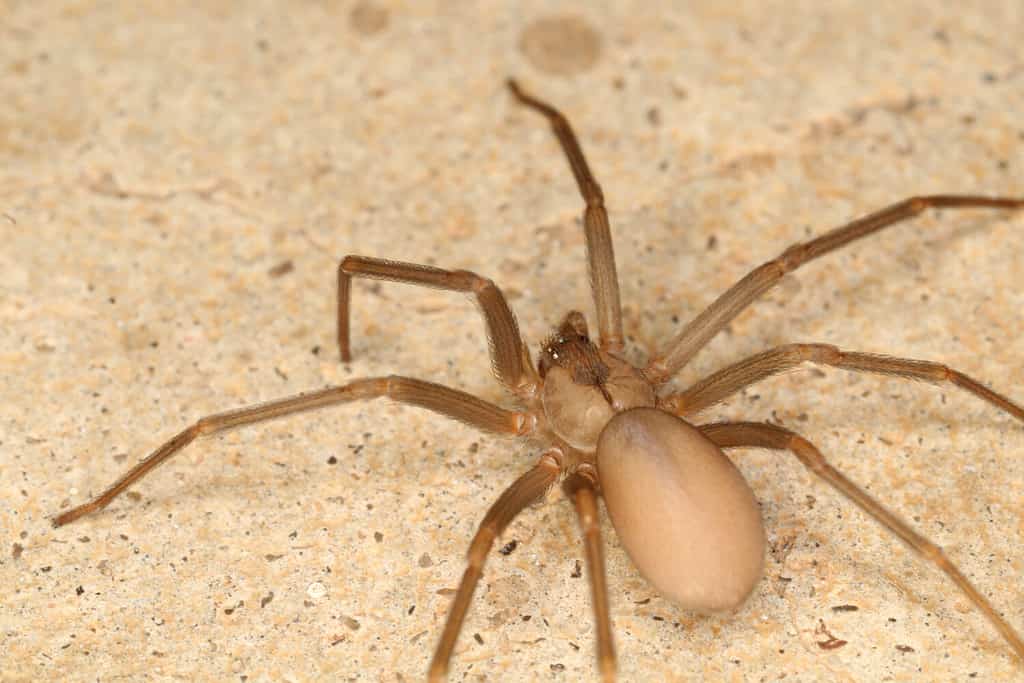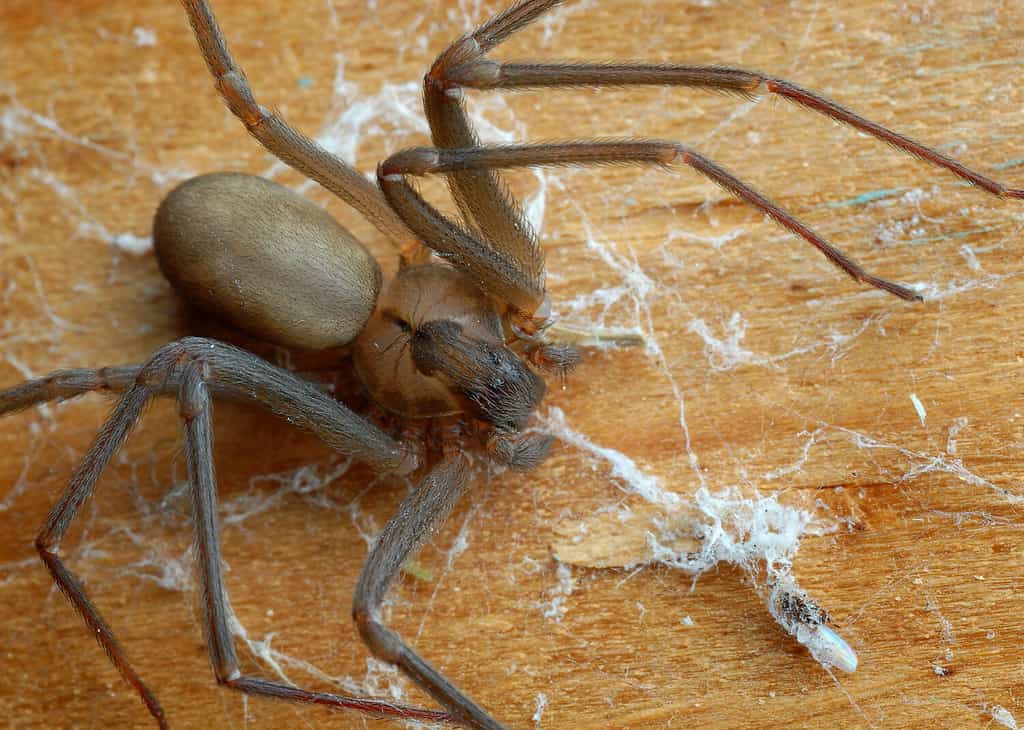The brown recluse is a member of a group commonly known as the violin or fiddle-back spiders. These members have violin-shaped markings on the cephalothorax (fused head and thorax). The intensity and shape of the fiddle design may differ, but the neck of the violin always points toward the abdomen. Another identifiable feature is the eye pattern on the front of the cephalothorax. Unlike other spiders, the brown recluse has six eyes instead of eight, with spaces between each. Brown recluse spiders in Louisiana are common in the northern region, but they are rare in the southern parts of the state.

The brown recluse is a member of a group commonly known as the violin or fiddle-back spiders. These members have violin-shaped markings on the cephalothorax (fused head and thorax).
©Nick626/Shutterstock.com
Brown Recluse Spiders in Louisiana
It’s terrifying to know that brown recluse spiders can be found in Lousiana homes, both indoors and outdoors. While it is quite common for these spiders to inhabit people’s homes and buildings, encounters with them are rare in Louisiana. But if they do get into your home, these spiders like to hide in closets, dark corners of a basement, inside your shoe or bed, and in areas with a lot of clutter.
Some consider the brown recluse more dangerous than the Black Widow because people are better at identifying the notorious black spider, with its distinctive red hourglass on its abdomen. On the other hand, the brown recluse is often mistaken for harmless house spiders. So, people don’t even realize they should be cautious of this venomous spider. Thankfully, bites from brown recluse spiders are uncommon in Louisiana, as these spiders usually only bite if in direct contact with the skin. But, since they also make their way into homes, bites are not unheard of, especially when someone accidentally steps on them or unknowingly enters their space.
Luckily the bite is painless, but unfortunately, this also means that many people don’t realize they’ve been bitten until much later. Symptoms of a brown recluse spider bite include:
- Nausea
- Lesions
- Fever
- Slow-healing wounds
- Infection
- Necrosis (death of cells) causes an excruciating and frightful “flesh-rotting” wound.

Symptoms of a brown recluse bite include lesions, slow-healing wounds, and necrosis.
©Robert D Brozek/Shutterstock.com
Where do Brown Recluse Spiders Live in Louisiana?
Brown recluse spiders are common in the northern regions of Louisiana but rarer in the southern areas of the state. These spiders inhabit dry areas, like log piles, rock piles, and caves. However, they also occur around homes, in places like wall voids, crawl spaces, overhangs, leaf litter, brush, and under woodpiles.
What do Brown Recluse Spiders Eat?
The brown recluse’s diet mainly consists of soft-bodied insects, like cockroaches, crickets, flies, and moths. Furthermore, they feed on each other, making them cannibalistic. These spiders differ from other arachnids as the webs they build are not for catching prey. Females build webs to form egg sacs.
Brown recluse spiders hunt at night by chasing down their targets. Once the prey is in their clutches, these spiders use their fangs to inject deadly venom into the insect to subdue it. But, like many spider species, brown recluse spiders don’t need to eat every day and can survive months without water or food.

The brown recluse differs from other spiders as the webs they build are not for catching prey. Females build webs to form egg sacs.
©Miles Boyer/Shutterstock.com
How to Get Rid of Brown Recluse Spiders?
Brown recluse spiders are efficient hunters, so they keep the insect population in a home under control. However, it’s understandable if you don’t want to share your home with a venomous spider. But, before going through all this trouble, you must determine if you have an infestation.
Signs You Have an Infestation
Just like most insects, the brown recluse spider likes to find shelter in dry, warm, and dark places. Additionally, they need access to food, so naturally, people’s homes are an ideal refuge. Unfortunately, these spiders rarely spin webs and are nocturnal, so they stay out of sight. Therefore it’s hard to tell they are in your home until an infestation occurs. However, there are signs one can look for:
- It is an immediate red flag if you spot a brown recluse during the day.
- Sheet-like webs in crevices or corners
- Egg sacs two to three inches in diameter attached to the sheet-like webs.
If you see any of these signs, it could indicate an infestation in progress. But do not panic; there are a few methods for ridding your home of these dangerous spiders.
Ridding Your Home of Brown Recluse Spiders
Firstly, homeowners must never try to solve a brown recluse infestation on their own. While a single bite might not be fatal, multiple bites can cause some serious harm, even death. As a result, contacting a professional pest control service is the best option. However, if you are hell-bent on doing this on your own, there are a few low-risk methods you can use, including:
Diatomaceous Earth
If you have a brown recluse spider infestation, try using diatomaceous earth, which is a powder made from crystalized aquatic organisms. Spread a thin coat of this powder over places these spiders will most likely visit. As the spiders tread over the powder, they are cut by the crystals and eventually dehydrate until they die. While this method takes longer than others, it is safe for humans and pets. However, the spiders must walk over the diatomaceous earth for it to be effective.
Sticky Traps
You can try to control the brown recluse spider population by placing sticky traps along ledges, in the basement, around windows, and in other areas you think these spiders might occur. As the spiders walk over the sticky trap, they get stuck and die from dehydration. But, again, this method is only effective if you place the traps in the correct place, so it’s best to try multiple techniques while using sticky traps. Furthermore, if you go this route, you need to swap out these traps regularly because a pile of dead brown recluse spiders is dangerous to pets or children. Alternatively, you can place them in hard-to-reach areas.
DIY Vinegar Solution
If you want to use a natural pesticide, many people believe in the power of vinegar or apple cider vinegar due to its acidity. All you have to do is spray the webs, egg sacs, or individual spiders with a water and vinegar mix. Additionally, you can also spray curtains, furniture, and other surfaces in the home to keep these spiders away. But, if you aim to kill individual spiders, you might consider using a heavier concentration of vinegar.
Repellents
Although brown recluse spiders are venomous, most people prefer to repel them instead of killing them. Therefore, essential oils like lemon, mint, and lavender work wonders at keeping these spiders at bay. It’s as easy as adding a few drops of essential oil to a spray bottle and spraying areas where the spiders are likely to visit.
Pesticides
If an infestation is too large for natural pesticides, it might be time to use the hard stuff. In fact, pesticides are usually the most effective way to eliminate a brown recluse infestation. Pesticides come in powders, sprays, and baits. However, these pesticides may have harmful effects on you and your pets, so always check if they are safe to use around children and animals. The best pesticide to use for brown recluse spiders has active ingredients like:
- Bifenthrin
- Cyfluthrin
- Lambda-cyhalothrin
- Deltamethrin
As a result, when spraying egg sacs, active webs, and individual spiders with these pesticides is a surefire way to reduce the population in your home.
The photo featured at the top of this post is © Nick626/Shutterstock.com
Thank you for reading! Have some feedback for us? Contact the AZ Animals editorial team.







